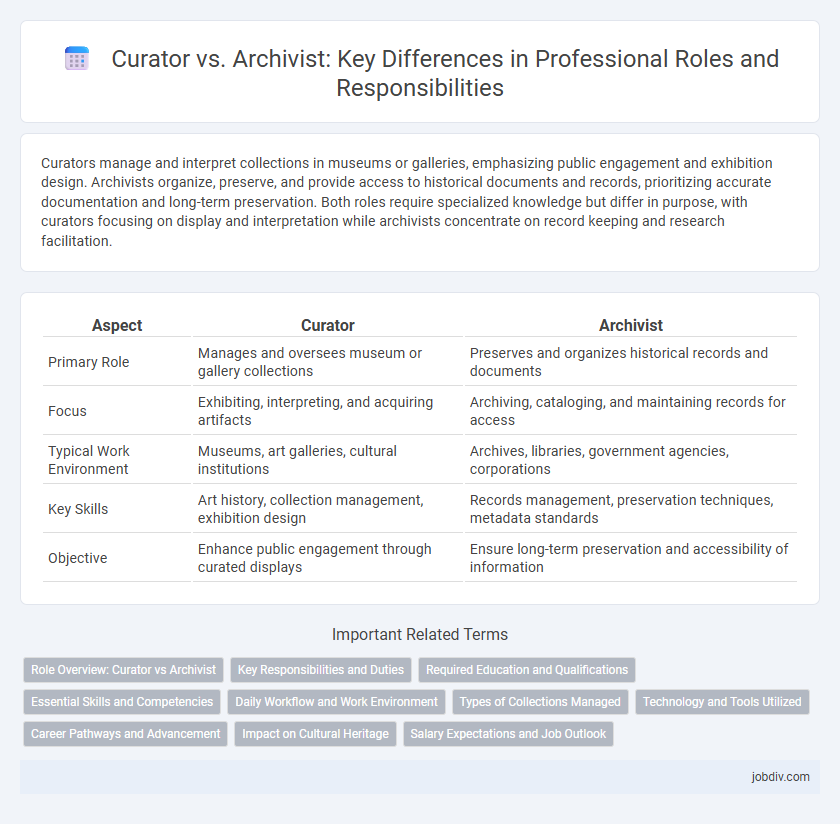Curators manage and interpret collections in museums or galleries, emphasizing public engagement and exhibition design. Archivists organize, preserve, and provide access to historical documents and records, prioritizing accurate documentation and long-term preservation. Both roles require specialized knowledge but differ in purpose, with curators focusing on display and interpretation while archivists concentrate on record keeping and research facilitation.
Table of Comparison
| Aspect | Curator | Archivist |
|---|---|---|
| Primary Role | Manages and oversees museum or gallery collections | Preserves and organizes historical records and documents |
| Focus | Exhibiting, interpreting, and acquiring artifacts | Archiving, cataloging, and maintaining records for access |
| Typical Work Environment | Museums, art galleries, cultural institutions | Archives, libraries, government agencies, corporations |
| Key Skills | Art history, collection management, exhibition design | Records management, preservation techniques, metadata standards |
| Objective | Enhance public engagement through curated displays | Ensure long-term preservation and accessibility of information |
Role Overview: Curator vs Archivist
Curators manage and interpret collections within museums and galleries, focusing on the acquisition, care, and exhibition of artifacts to engage and educate the public. Archivists specialize in preserving, organizing, and maintaining historical records and documents, ensuring long-term accessibility and authenticity for research and legal purposes. Both roles require expertise in collection management but differ in the nature of materials handled and audience engagement strategies.
Key Responsibilities and Duties
Curators manage the acquisition, interpretation, and exhibition of collections to engage and educate the public, ensuring the preservation and contextualization of artifacts. Archivists specialize in appraising, organizing, and maintaining records and documents for long-term preservation and accessibility, often supporting research and legal needs. Both roles require meticulous attention to detail and expertise in maintaining the integrity and provenance of cultural or historical materials.
Required Education and Qualifications
Curators typically require a master's degree in museum studies, art history, or a related field, along with specialized knowledge in their collection's subject area. Archivists usually hold a master's degree in library science, archival science, or information management, emphasizing skills in preservation, organization, and digital curation. Both professions demand strong research abilities, attention to detail, and experience with database management systems relevant to their respective domains.
Essential Skills and Competencies
Curators excel in collection development, exhibition planning, and public engagement, requiring strong research skills, art or historical knowledge, and communication abilities. Archivists specialize in records management, preservation techniques, and metadata standards, demanding expertise in information organization, digital archiving technologies, and attention to detail. Both professions require critical thinking, project management, and familiarity with legal and ethical considerations related to cultural heritage.
Daily Workflow and Work Environment
Curators primarily manage and interpret collections within museums or galleries, overseeing exhibitions, conducting research, and collaborating with educational teams in structured office and gallery environments. Archivists focus on appraising, preserving, and organizing historical records and documents, often working in climate-controlled archives or records centers with meticulous attention to detail and digital cataloging systems. Both roles require strong organizational skills but differ in daily tasks, with curators engaging more in public programming and archivists concentrating on preservation and accessibility of information.
Types of Collections Managed
Curators primarily manage art, historical artifacts, and cultural collections within museums and galleries, emphasizing exhibition design and public engagement. Archivists handle records, documents, and manuscript collections that preserve organizational, legal, and historical information, ensuring accessibility and preservation. Both roles require specialized knowledge, but curators focus on interpretive display while archivists prioritize systematic organization and long-term record maintenance.
Technology and Tools Utilized
Curators leverage digital asset management systems and interactive display technologies to enhance exhibit curation and visitor engagement. Archivists utilize specialized archival software such as Archivematica and digital preservation platforms to catalog, preserve, and provide access to historical records and sensitive data. Both roles increasingly rely on AI-driven metadata tagging and cloud storage solutions to improve information retrieval and long-term preservation.
Career Pathways and Advancement
Curators typically advance by gaining expertise in art history or museum studies and often move into senior roles managing exhibitions, collections, or institutions. Archivists progress through specializations in records management or digital preservation, securing positions in government agencies, corporate sectors, or academic archives. Both careers benefit from advanced degrees and experience, but curators may have broader opportunities in public engagement while archivists focus on information organization and compliance.
Impact on Cultural Heritage
Curators shape cultural heritage by selecting, interpreting, and exhibiting artifacts, making historical narratives accessible and engaging for the public. Archivists preserve and organize primary source materials, ensuring the authenticity and integrity of records that underpin cultural memory. Both roles are crucial for maintaining cultural heritage, with curators emphasizing public interaction and archivists focusing on long-term preservation and research.
Salary Expectations and Job Outlook
Curators typically earn an average salary ranging from $50,000 to $70,000 annually, with opportunities for higher earnings in prominent institutions or specialized fields. Archivists' salaries generally fall between $45,000 and $65,000, reflecting demand in government agencies, universities, and corporate sectors. The job outlook for both roles is steady, with archivists experiencing a slightly faster growth rate due to increasing digital record management needs.
Curator vs Archivist Infographic

 jobdiv.com
jobdiv.com